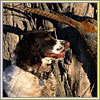

|
|
Hunting Dog
Hunting may be the job that comes most naturally to dogs, as
all dogs descend from that great hunter of the animal world,
the wolf. Since our first association with dogs in the Stone
Age, humans have trained dogs big and small to hunt nearly
every animal on Earth. These range from Rhodesian ridgebacks
bred to challenge lions in Africa, to dachshunds engineered to
go after badgers in their narrow dens. Today, hunting with
dogs is mostly a sport. Here, a spaniel stands beside recently
retrieved pheasants in England.
|


|
|
Land Mine Dog
A member of Thailand's Humanitarian Mine Action Unit uses a
mine-detecting dog to search for land mines in a village east
of Bangkok. Mine-detecting dogs are trained—against
their instincts—to walk in straight lines while
searching. They can usually smell things situated four inches
underground, but they can be taught to smell objects at even
greater depths. With their ultra-sensitive noses, dogs have
proven among the most effective tools for mine detection and
have helped to prevent thousands of injuries and deaths in
war-torn countries around the world.
|
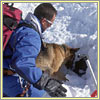

|
|
Rescue Dog
A mountain patrol officer and a German shepherd practice
rescue techniques in the French Alps. Officers here often
conduct search-and-rescue operations in avalanche situations.
Search-and-rescue dogs are trained to search out the odor
given off by humans trapped beneath collapsed structures or
natural debris. They alert their handlers by barking at the
site where a victim lies, and, depending on how the dogs react
to what they've found, handlers know from a distance whether
the victim is alive or dead, even whether he or she is
uninjured or severely injured.
|
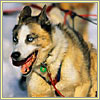

|
|
Sled Dog
Huskies tearing through the streets of Anchorage mark the
annual start of the Iditarod Trail Sled Dog Race, a 1,049-mile
trek across the Alaskan wilderness that combines human and
canine athletic abilities. Although some native Alaskans in
remote areas still drive sled-dog teams for transportation,
most sled dogs are now used purely for sport. Mushers largely
choose huskies to pull their sleds as they are the best
pullers, having been bred to do so for thousands of years in
the arctic.
|
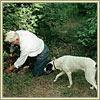

|
|
Truffle Dog
Trained hounds like this one in the Tuscany region of Italy
have excellent noses for truffles. Today, hunters seeking the
gourmet fungi usually use dogs to help locate their quarry,
despite a long tradition of truffle pigs. Since truffles can
bring over $600 per pound, dogs are a better bet than
truffle-sniffing pigs, which tend to eat what they find.
|
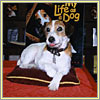

|
|
Acting Dog
As with human actors, fame among the canine variety can beget
book deals. Here, Moose, the Jack Russell terrier who plays
Eddie on the hit T.V. series "Frasier," promotes his book,
My Life as a Dog. Trainers, hoping to groom the next
Lassie or Rin Tin Tin, pluck at least half of all the dogs in
the entertainment business (although not Moose) from animal
shelters.
|
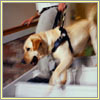

|
|
Assistance Dog
Dogs who serve people in their everyday lives are called
assistance dogs. Over just the past 75 years, people have
trained dogs to perform numerous tasks to help people who are
blind, deaf, or mobility-impaired. Guide dogs for the blind
and service dogs for the mobility-impaired are usually golden
retrievers, Labs, or German shepherds because of their
strength, size, and receptiveness to training. Hearing dogs
serving the deaf can be any kind of dog when given special
training, even a tiny Yorkshire terrier.
|
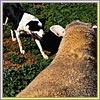

|
|
Herding Dog
Herding is a centuries-old canine occupation that has a long
tradition in Great Britain, home to this collie and its herd
of sheep. As with all working dogs, yet even more so with
herders, these dogs must not only be good at their task, but
they must easily develop a close collaborative friendship with
their human bosses. They must also be undaunted by much larger
animals that might kick or trample them if they're not
vigilant. Bred for stamina, herding dogs work with their
masters all day in the fields and take verbal orders from a
distance.
|
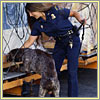

|
|
Drug Dog
No dog is genetically programmed to recognize the scent of
narcotics, but any dog trained for detection work can learn to
sniff for drugs. Dogs have at least 200,000 more olfactory
receptors than humans do, so even substances we consider
odorless can waft a powerful whiff toward a dog's nostrils. In
the U.S., the Transportation Security Agency, the Federal
Aviation Administration, the F.B.I, and Customs officials all
depend on dogs to locate an ever-increasing selection of
illegal narcotics quickly and without bias.
|
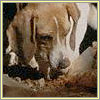

|
|
Termite Dog
Scent dogs trained from puppyhood can detect termites with
their sensitive noses, as the insects give off telltale
methane gas produced by microorganisms in their digestive
tracts. This beagle is seeking pests in a house's insulated
crawl space. Exterminators often credit their termite-hunting
beagles and Labrador retrievers with locating infestations in
areas of a house or building where there are no apparent signs
of termites, a testament to the dogs' unique skill.
|

|

|

